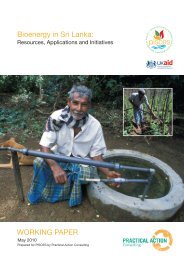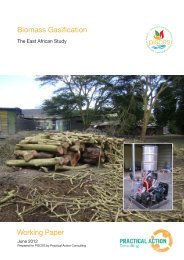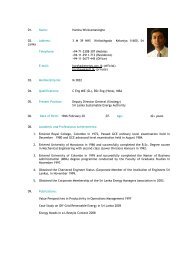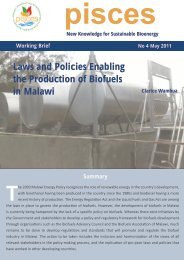Liquid Biofuels Strategies and Policies in selected African ... - Pisces
Liquid Biofuels Strategies and Policies in selected African ... - Pisces
Liquid Biofuels Strategies and Policies in selected African ... - Pisces
Create successful ePaper yourself
Turn your PDF publications into a flip-book with our unique Google optimized e-Paper software.
The emerg<strong>in</strong>g <strong>African</strong> biofuels <strong>in</strong>dustry is also at risk from the impact of the chang<strong>in</strong>gweather patterns that they are meant to mitigate. Some climate models predict<strong>in</strong>creas<strong>in</strong>g drought or flash flood<strong>in</strong>g, particularly across the whole of the Sahel <strong>and</strong>down the Eastern Coastal zone. Increased deforestation, with loss of well-adapted<strong>in</strong>digenous species, the consequent <strong>in</strong>creased pressure on water resources <strong>and</strong> lossof traditional drought pastures <strong>and</strong> wetl<strong>and</strong>s, can greatly <strong>in</strong>crease the vulnerability <strong>and</strong>accelerate the demise of whole communities, ways of life <strong>and</strong> ecosystems.Comparisons with Brazil seldom account for the amount of available l<strong>and</strong> <strong>in</strong> Brazil,or its currently stable climatic conditions. On the other h<strong>and</strong>, India, subject to the<strong>in</strong>creas<strong>in</strong>g vagaries of monsoonal patterns, has failed to achieve either sugarcanebasedethanol targets or its orig<strong>in</strong>al jatropha biodiesel production targets (Iiyama M,Odongo F. 2009). In addition, many Sub-Saharan <strong>African</strong> countries are water scarce.These risks can be partly mitigated by follow<strong>in</strong>g Brazil’s example of implement<strong>in</strong>gagro-climatic zon<strong>in</strong>g to reduce food for fuel competition <strong>and</strong> r<strong>in</strong>g-fenc<strong>in</strong>g areas of highconservation value, which had already been started <strong>in</strong> Kenya.2.2.2 The risks of depend<strong>in</strong>g on Climate Change Market Systems <strong>and</strong>Foreign Direct InvestmentWhether many people at all levels of society <strong>in</strong> Africa benefit, or are left at an evengreater risk, <strong>and</strong> <strong>in</strong> deeper poverty, will <strong>in</strong> part be determ<strong>in</strong>ed by fund<strong>in</strong>g. How muchis available to do what? When the potential threat of climate change f<strong>in</strong>ally started tobe taken seriously at a global level, the aim was for (ma<strong>in</strong>ly developed) countries to cutback on their usage of fossil fuels <strong>and</strong> become much more energy efficient. This hasbeen met with strong resistance, particularly from the US <strong>and</strong> Ch<strong>in</strong>a. The orig<strong>in</strong>al UNFramework Convention on Climate Change set future trends by design<strong>in</strong>g a marketbasedapproach which does not, <strong>in</strong> reality, slow the amount of fossil fuels used <strong>and</strong>the amount of GHGs released <strong>in</strong>to the atmosphere. Countries or corporations are ableto reduce emissions by buy<strong>in</strong>g “carbon credits” from low emitt<strong>in</strong>g countries, as well asby <strong>in</strong>vest<strong>in</strong>g <strong>in</strong> projects that allegedly store carbon.Similarly the Clean Development Mechanism (CDM) was developed to allow pollutersto offset their emissions by <strong>in</strong>vest<strong>in</strong>g <strong>in</strong> Carbon sav<strong>in</strong>g projects located <strong>in</strong> develop<strong>in</strong>gcountries. In essence this was meant to further promote susta<strong>in</strong>able <strong>and</strong> “clean”development to <strong>African</strong> countries, while at the same time allow<strong>in</strong>g the emitt<strong>in</strong>g countryto atta<strong>in</strong> its emission targets.One of the most popular market-based schemes is the use of biofuels as an alternativeto petroleum as part of m<strong>and</strong>atory blend<strong>in</strong>g targets set by the EU, US <strong>and</strong> others.Currently there is a huge, <strong>and</strong> possibly <strong>in</strong>satiable, gap between dem<strong>and</strong> <strong>and</strong> supply. Thevision promulgated by countries, multilateral fund<strong>in</strong>g <strong>in</strong>stitutions, the UN, <strong>and</strong> the privatesector (<strong>in</strong>clud<strong>in</strong>g private banks <strong>and</strong> bilateral donors) has been to promote <strong>and</strong> supportf<strong>in</strong>ancially a large-scale agro-<strong>in</strong>dustrial biofuels production model with foreign ownedplantations across the tropics feed<strong>in</strong>g developed countries needs.To confuse matters even more, biofuels have enabled some mult<strong>in</strong>ational corporationsto lease or buy large tracts of <strong>African</strong> farml<strong>and</strong> <strong>in</strong> the name of ‘green eco-fuels’ <strong>and</strong>part of the fight to ‘slow climate change, <strong>and</strong> so potentially ga<strong>in</strong> additional revenuesfrom the carbon offset markets. Whether or not they are green or do slow climatechange is becom<strong>in</strong>g <strong>in</strong>creas<strong>in</strong>gly controversial.It is clear that m<strong>and</strong>ated biofuels blend<strong>in</strong>g targets <strong>in</strong> the EU / USA <strong>and</strong> other largemarkets has driven much biofuels <strong>in</strong>vestments through <strong>in</strong>centives, an assured market<strong>and</strong> tax <strong>in</strong>centives. As the scale of <strong>African</strong> ‘l<strong>and</strong> grabb<strong>in</strong>g’ or <strong>in</strong>vestment has becomeapparent, advocacy groups call not only for strong susta<strong>in</strong>ability criteria to become law,but also for the EU to scrap biofuels blend<strong>in</strong>g targets (Friends of the Earth 2010). It maystop a few projects, but stricter biofuels import criteria could also push food productiononto more vulnerable l<strong>and</strong>. Given that, so many players <strong>and</strong> markets are <strong>in</strong>creas<strong>in</strong>gly<strong>in</strong>volved, it is unclear that tighter criteria <strong>in</strong> one region would have much effect.This <strong>in</strong>tense political will <strong>and</strong> substantial f<strong>in</strong>ancial <strong>and</strong> technical support greatly<strong>in</strong>tensifies the pressure on <strong>in</strong>digenous l<strong>and</strong>s <strong>and</strong> resources, as well as decreas<strong>in</strong>gthe capacity <strong>and</strong> will of governments to regulate corporate behaviour strongly.With new f<strong>in</strong>ancial mechanisms strengthen<strong>in</strong>g the carbon market, huge loans havebeen provided to the private sector to exp<strong>and</strong> biofuels production, <strong>and</strong>, as with oilproduction, some key stakeholders st<strong>and</strong> to greatly benefit f<strong>in</strong>ancially.In a common sense world, the need to develop more profit for <strong>in</strong>vestors from these hugef<strong>in</strong>ancial resources would be balanced with equity <strong>and</strong> <strong>in</strong>clusion to create <strong>in</strong>tegrated,<strong>in</strong>novative, efficient <strong>and</strong> susta<strong>in</strong>able solutions that benefit many people rather than justa few. At the moment, whether this happens or not is completely reliant on <strong>in</strong>cumbentm<strong>in</strong>isters <strong>and</strong> governments. There is currently little or no comparable fund<strong>in</strong>g ortechnical assistance to help countries implement laws that protect <strong>in</strong>digenous peoples’rights to l<strong>and</strong>s; protect natural resources; meet obligations to <strong>in</strong>ternational human rightsconservation; or support treaties to reform exist<strong>in</strong>g l<strong>and</strong> tenure systems that can createclear l<strong>and</strong> demarcations, l<strong>and</strong> titles for <strong>in</strong>digenous communities, <strong>and</strong> <strong>in</strong>sist on <strong>in</strong>tegrateddevelopment projects (Taukli-Corpuz, 2007).If local people, who best underst<strong>and</strong> the l<strong>and</strong> <strong>and</strong> conditions, are consulted, it is rarelyon an equal foot<strong>in</strong>g with heavily resourced companies, backed by large multilateralfunders <strong>and</strong> potentially vested local <strong>in</strong>terests. Current ways of life, such as forestdwell<strong>in</strong>g or pastoralism <strong>and</strong> their contribution to national economies are not factored<strong>in</strong>. They are often seen as mostly dispensable <strong>and</strong> backward <strong>and</strong> their contributions,such as to dairy <strong>and</strong> beef <strong>in</strong>dustries, are often forgotten or poorly valued. At onerecent meet<strong>in</strong>g <strong>in</strong> Kenya, those oppos<strong>in</strong>g the possible destruction of a forest rated asan ‘important bird area’ were described by the <strong>in</strong>vestors as ‘aga<strong>in</strong>st development’ <strong>and</strong>‘enemies of the local people’ (Gatonye G 2010). Several Ug<strong>and</strong>ans died <strong>in</strong> the struggleto reverse the de-gazett<strong>in</strong>g of part of Mabira Forest Reserve for a sugar plantation <strong>in</strong>2007 (Barry, 2007) with President Museveni stat<strong>in</strong>g at the time that ‘conservation isthe privilege of the rich’. The decision was reversed when it was demonstrated thatthe commercial value of tourism <strong>and</strong> carbon capture <strong>in</strong> Mabira was estimated at morethan $316 million (£154 million) a year, whereas sugar cane production would be worthless than $20 million. The expansion of sugar production was moved to areas thatwere perceived as less valuable.Concern has been raised recently that many of the companies <strong>in</strong>vest<strong>in</strong>g <strong>in</strong> biofuels arestructur<strong>in</strong>g their f<strong>in</strong>ances or be<strong>in</strong>g given tax breaks which allow them to avoid pay<strong>in</strong>gtax <strong>in</strong> the countries of operation (Kar, 2010). Thus <strong>African</strong> countries as a whole ga<strong>in</strong>relatively little benefit from the use of their l<strong>and</strong>, water <strong>and</strong> labour. Controls <strong>and</strong> an<strong>in</strong>tegrated vision have to come from with<strong>in</strong>. It is up to <strong>African</strong> governments to ensurethat developed countries do not export their worst unsusta<strong>in</strong>able practices to Africaor allow Africa’s natural resources to be exported without also creat<strong>in</strong>g real growthfor their rural populations. With so many people ready to <strong>in</strong>vest, the ball is firmly <strong>in</strong>16 <strong>Liquid</strong> <strong>Biofuels</strong> <strong>Strategies</strong> <strong>and</strong> <strong>Policies</strong> <strong>in</strong> <strong>selected</strong> <strong>African</strong> Countries <strong>Liquid</strong> <strong>Biofuels</strong> <strong>Strategies</strong> <strong>and</strong> <strong>Policies</strong> <strong>in</strong> <strong>selected</strong> <strong>African</strong> Countries 17









